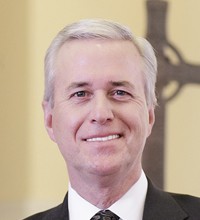“Real religion has never ever imagined that it was possible to split up the twin sisters of beauty and truth,” preached the Rev. M. Craig Barnes in his inaugural address as the 7th President of Princeton Theological Seminary.
Amidst delegates from 37 seven academic institutions, 18 delegates from churches and denominations including representatives from as far away as Africa, India and as nearby as Trenton and Princeton itself, Barnes was inaugurated on Wednesday, Oct. 23 in the Princeton University Chapel.
The inauguration on this fall day brought alumni from east and west, north and south. The service began with a procession of seminary presidents, ecumenical guests, professors and clergy in full academic regalia right out of the middle ages into the vaulted stone cathedral that is the university chapel ― and included a live stream on the internet for those who wanted to join in the celebration from afar.
It was as though two worlds were coming together ― old and new, tradition and the future, the history of the institution that is Princeton Theological Seminary and the desire for the agility that is a trademark of our postmodern world.
But those were not the only two worlds joined together as Barnes ascended the pulpit in the gothic splendor of the Princeton University Chapel.
“Presbyterians have long claimed that truth is in order to goodness,” said Barnes. But we in the Reformed body of the church have had a tendency to, as Barnes described it, “stick with the words because we thought that words were safe.”
The struggle, with which he challenged those gathered, is to behold both the truth and the beauty of a God in whose image we are made.
“We need to ‘behold’ so much more than we need to win arguments,” said Barnes.
It is a vision to which he believes the seminary is called.
At the close of his address Barnes recounted a story from the book Leading Without Power ― which, in and of itself is an interesting choice for a seminary president.
The story is that of the Hermitage museum in 1941 St. Petersburg with the Nazis approaching. Wanting to save the great works of art, they were sent off to the farthest reaches of the country for safe keeping. All that was left were empty frames on the wall, pedestals where statues once stood.
Yet, in the midst of this, docents continued to give tours, to point to where the art had been, and to describe what should have been there, as visitors looked on ― to the blank walls ― with rapt attention.
“That,” said Barnes, “is what we are trying to do with a seminary ― to describe the beauty and truth that should be in the world.”
It is a calling to take words seriously but to live those words out so that their beauty is revealed.
“Our task here is not just to talk truth,” Barnes concluded, “but to help our students, churches, and the world around us to behold it.”

